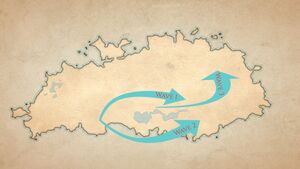Difference between revisions of "Dawn"
| Line 12: | Line 12: | ||
In contrast, the migrants of the New Dawn clearly had a common cultural background and spoke a closely related set of [[Thonthal]]-like languages. | In contrast, the migrants of the New Dawn clearly had a common cultural background and spoke a closely related set of [[Thonthal]]-like languages. | ||
| + | |||
| + | == Three waves of migration == | ||
| + | |||
| + | [[File:Dawn waves.jpg|thumb|The three waves of migration]] | ||
| + | |||
| + | Researchers typically differentiate between the three waves of migration. These are not necessarily chronological, but designate the main migration streams that ended up resulting in very different countries, cultures, languages and religions. | ||
| + | |||
| + | The first wave has populated Gantolia and Yammoe. The second wave resulted in Loodori, and later Ybuwyn. The third wave established the [[State of Asdoh]], [[Toor]] and possibly [[Dlos]]. The latter is sometimes considered the fourth wave of Dawn. | ||
Revision as of 00:52, 21 March 2021
Dawn is the name given to a wave of migration from the Western Dantrian civilization to the central and eastern parts of the Continent that happened in the course of several centuries, beginning in the middle of the first revolution. Travelers would cross the arid planes of Nari into what later would become Gantolia and Yammoe.
The Dawn is contrasted to the New Dawn, a migration wave from Central Dantria that occurred in the second half of the second revolution across the Ouna desert.
Reasons for the migration
Reasons for the Dawn are unknown. In addition to that, the development of several original languages, religions and cultures of the migrants provides an anthropological mystery: these cultures ended up having little in common with one another, while the expectation is that migrants from Western Dantria would have a relatively common cultural background. For instance, Lolion, which was the main religion in Dantria, seemed to be virtually unknown to the Dawn settlers. Instead, Lolion was later exported by its monks through Gantolia almost 10 centuries later.
This could be explained by the supposed extreme diversity of population of Dantria, and possibly the coexistence of many languages and religions, although it begs the question of what prompted such different peoples to embark on a dangerous and faraway journey. Hypotheses include famine, war, disease and cultural prosecution, but none of these ideas explain features of the Dawn to full satisfaction. Surviving Dantrian documents, although few, reveal nothing of importance happening at the time of the Dawn. For instance, there is a historic treatise written by an unknown author from Walneer that dates its account to the end of the 16th and the beginning of the 17th CFR. It talks about some of the important events of the previous decades, but none of them feature anything that would prompt a massive migration.
At the same time, the settlers have seemingly exported sophisticated technologies, such as road building and architecture, and well developed forms of government. Tarnarian royal ranks are believed to have originated in Dantria, or at least inspired by Dantria.
In contrast, the migrants of the New Dawn clearly had a common cultural background and spoke a closely related set of Thonthal-like languages.
Three waves of migration
Researchers typically differentiate between the three waves of migration. These are not necessarily chronological, but designate the main migration streams that ended up resulting in very different countries, cultures, languages and religions.
The first wave has populated Gantolia and Yammoe. The second wave resulted in Loodori, and later Ybuwyn. The third wave established the State of Asdoh, Toor and possibly Dlos. The latter is sometimes considered the fourth wave of Dawn.
